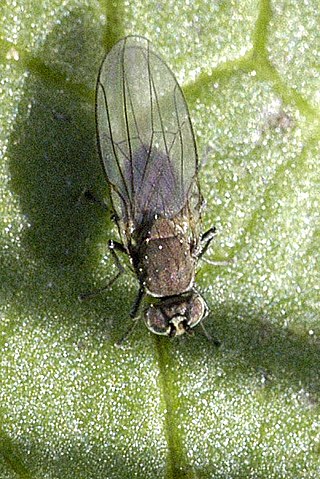Top Qs
Timeline
Chat
Perspective
Ephydridae
Family of flies From Wikipedia, the free encyclopedia
Remove ads
Ephydridae (shore flies, sometimes brine flies) is a family of insects in the order Diptera. Shore flies are tiny flies that can be found near seashores or at smaller inland waters, such as ponds. About 2,000 species have been described worldwide,[2] including Ochthera.
This article includes a list of general references, but it lacks sufficient corresponding inline citations. (January 2025) |
The petroleum fly, Helaeomyia petrolei, is the only known insect whose larvae live in naturally occurring crude petroleum. Another notable species is Ephydra hians which lives in vast number at Mono Lake.
Remove ads
Description


The flies are minute to small (0.9 to 7.0 mm), with black or gray colorations. Wings are sometimes patterned. Costa with two interruptions are present in first section, near the humeral cross-vein and again near the end of vein 1. The second basal cell is not separated from the discal cell. Arista are bare or with hairs on the upper side (plumose on the upper side). The mouth opening is very large in some species. The ratio of vertical diameter of eye and height of gena (face index) is widely used in identification of individual species.
Remove ads
Larvae
In the tribe Notiphilini the head is reduced to a cephalic skeleton, there are no anterior spiracles and the posterior spiracles are extended as spines. The other taxa have larvae similar to the Sciomyzidae, with the posterior spiracles at the apices of divergent branches from a common base. They may be differentiated by short thoracic segments (like the abdominal ones) and by the absence of a ventral arch linking the mouth hooks.
Remove ads
Habitats
Summarize
Perspective
Ephydridae occupy a diverse array of seashore and wetland habitats including hot springs, petroleum pools, salt pools, alkaline lakes, marshes. Imago are phytophagous, sometimes feeding on microscopic algae and bacteria (Paracoenia, Ephydra), or predatory (Ochthera, Ephydrinae). As larvae, many are phytophagous, grazing on aquatic plants (including cultivated rice), others are algal grazers or saprophagous. Larvae of Trimerina are predatory. Some species are an important food source for other animals. Others cause damage to agricultural crops.[3]
Larvae of some Ephydridae live in very unusual habitats. For example, Ephydra brucei lives in hot springs and geysers where the water temperature exceeds 45 degrees Celsius; some Scatella live in hot sulphur springs; Helaeomyia petrolei develops in pools of crude oil; and Ephydra cinerea, the brine fly proper, in pools with very high concentrations of salt. Some have public health significance being associated with sewage filter beds and septic tanks. Flies develop in moist soils or mine leaves of aquatic, subaquatic, and rarely dry soil (Hydrellia) plants. Flies are found near water along coasts, among aquatic vegetation and sometimes on water surfaces (Ephydra).
Phylogeny
|
| ||||||||||||||||||||||||||||||||||||||||||
| McAlpine (1989)[4] | Grimaldi (1990)[5] |
See also
References
External links
Wikiwand - on
Seamless Wikipedia browsing. On steroids.
Remove ads

